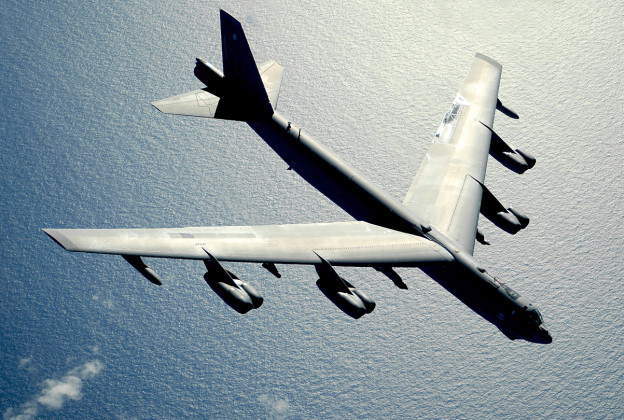
Two unarmed U.S. military planes flew through a section of international airspace to which China has claimed extra rights, Pentagon officials confirmed to USNI News Tuesday afternoon.
Monday night two planes from Andersen Air Force Base, Guam flew near the disputed Senkaku Islands within an area the Chinese have declared as an Air Defense Identification Zone (ADIZ) last week, U.S. Air Force Lt. Col. Tom Crosson told USNI News.
The training mission was a “long planned training sortie” and “was on the books and in planning well before the zone was established,” Crosson said.
A report in the Wall Street Journal identified the aircraft as Boeing B-52 Stratofortresses based in Guam.
View U.S. Planes Buzz China’s Air Claim in a larger map
Chinese state-run media announced the zone on — which borders Taiwan to the South and Korean territorial claims in the North — on Saturday and claimed that the piece of international airspace required flight plans through the region be filed with Chinese officials and flights deemed by the Chinese as unauthorized could face, “emergency defensive measures.”
Japan and the U.S. have both said they oppose the move from China.
“We view this development as a destabilizing attempt to alter the status quo in the region,” U.S. Secreatary of Defense Chuck Hagel said in a Saturday statement.
“This announcement by the People’s Republic of China will not in any way change how the United States conducts military operations in the region.”
China’s move is not unprecedented. There are a number of similar zones around the world, including a Japanese ADIZ which overlaps the new Chinese one. There are also ADIZ surrounding North America.
It is important to note that the ADIZs are over international waters and the legalities that govern them are murky at best. For example, Japan’s ADIZ encompasses it economic exclusion zone and also overlaps Taiwan’s ADIZ—which has caused tensions in the past.
The ADIZ airspace is not “claimed” by whichever party is trying to enforce the zone. All a nation or party in question can do is ask for the identification, location and try to claim air traffic control of civil aircraft—and back the claim up with the threat of interception. But the exact legal mechanism under international law is murky. The U.S. government, for example, enforces its ADIZs under legal theory that a nation has the right to set the conditions of entry into its territory.
“International law does not prohibit nations from establishing air defense identification zones (ADIZ) in the international airspace adjacent to their territorial airspace,” the U.S. Navy’s Commander’s Handbook on the law of Naval Operations. “The legal basis for ADIZ regulations is the right of a nation to establish reasonable conditions of entry into its territory. Accordingly, an aircraft approaching national airspace can be required to identify itself while in international airspace as a condition of entry approval.”
Of note for this particular, ignoring the Chinese ADIZ is standard procedure for the U.S. government.
“The United States does not recognize the right of a coastal nation to apply its ADIZ procedures to foreign aircraft not intending to enter national airspace nor does the United States apply its ADIZ procedures to foreign aircraft not intending to enter U.S. airspace,” the Handbook states.
“Accordingly, U.S. military aircraft not intending to enter national airspace should not identify themselves or otherwise comply with ADIZ procedures established by other nations, unless the United States has specifically agreed to do so.”
The aircraft came of out Andersen Air Force Base on Guam. Though the installation is enormous, Andersen AFB does not have any permanently assigned warplanes that are based there. Instead, the USAF regularly rotates strategic bombers and fighters into Andersen AFB as part of what it calls theatre security packages. In recent years there have been Boeing B-52, Rockwell International B-1 Lancers and Northrop Grumman B-2 stealth bombers. Additionally, fighter like the Lockheed Martin F-22 Raptor and Boeing F-15 Eagle also rotate through the base and Northrop RQ-4 Global Hawks are often staged there.
The current bomber unit on rotation to Andersen AFB flies B-52s. Though the last B-52H was delivered to the USAF in 1962, the aircraft remains the mainstay of the service’s bomber fleet. Though modern air defenses consign it to remain outside of highly contested airspace, the B-52 can carry both conventional and nuclear-tipped air launched cruise missiles, which keep it relevant against current high-end threats. The B-52 has the ability to fly more than 7,652 nautical miles without aerial refueling—which with one trip to the tanker—is more than enough to make it to the Chinese ADIZ. Effectively, the aerial refueling, the B-52’s range is limited only by the consumables like engine oil and the endurance of its crew.
According to Crosson, the plane underwent at least one aerial refueling during the training mission.




